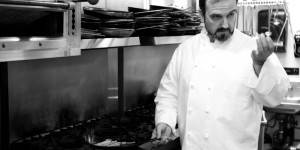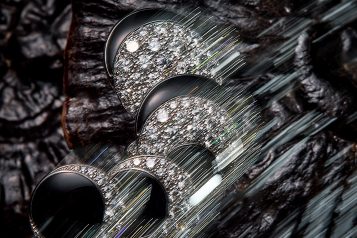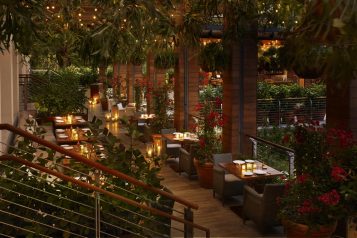On my recent visit to erbaluce, chef/owner Charles Draghi held court in his airy dining room, explaining an Italian red during one of his special wine dinners. Diners were captivated as they enjoyed Draghi’s well-executed, herb-infused Italian cuisine that’s influenced by his roots in Piedmont, Italy. And indeed, I was, too. The sunflower appetizer, on par in taste and texture to an artichoke heart, was one of the most unique dishes I’ve tasted. The gnocchi was sublime—and as with the sunflower, unlike any other rendition, with pork, lemon and herbs, not the usual tomato sauce or brown butter. Draghi, in fact, doesn’t use butter. Many of his sauces are made from vegetable and herb infusions, not butter or cream—certainly a rare and noteworthy technique. That’s what’s wonderful about erbaluce: it’s full of surprises not often encountered. It’s no wonder erbaluce won Best Pre-Theatre restaurant from The Improper Bostonian (July 2010). Chef Charles Draghi and his lovely partner Joan Johnson have set a stage in Boston’s Bay Village where the main players—ingredients, techniques and the passionate chef behind it all—have created an award-winning experience.
Haute Living: What’s new at erbaluce?
Chef Charles Draghi: Since I base every menu on the ingredients I find at the Farmers’ Market, and the catch that is brought to me by local fishermen, I am excited by the wealth of options offered to me at this time of year. The best of summer tomatoes, corn, peppers, peaches, etc. share the stalls with autumn squashes, parsnips, turnips, apples, and the like. It could be my favorite time of year for the gain of any of these ingredients, but there are a few that particularly get my chef’s passion going: one of those is Silver Queen corn. This is the incredibly sweet, creamy, and slightly salty white corn that few farmers grow anymore. But it is very worth the wait into mid-September to search for this delicacy. I’m making a risotto with the Silver Queen corn, roasted, and folded in with some roasted parsnips, aged pecorino cheese, and tarragon. Then I top the dish with some very thinly-sliced lardo, that I made from the fat back of a 200 pound organic Tamworth pig that I purchased from a small farm on the South Shore. The lardo has been cured in a traditional mixture of sea salt, rosemary, juniper, and pepperoncino. This is a very silky, opulent dish that tastes of the fields and sun.
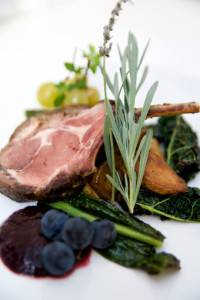
HL: What are some of your favorite dishes at erbaluce?
CD: The roasted rack of wild boar with a mosto of wild Concord grapes fermented with lavender branches is my signature dish, and has been for the past 12 years (since the Marcuccio’s days). It is one of my favorites. I love the nutty-sweet taste of wild boar, which is actually from a feral animal, and not farm raised. It has a steak-like texture that is very satisfying, and a subtly haunting, primal flavor, that is unlike any other meat.
Whenever they are available—and I’m never sure just when that is—I love the razor clams that I get from the Cape. I cook them in a Trieste-style; steamed with white wine, green peppercorns, fennel, garlic, and thyme. I also add in some julienned leeks, and serve the clams and broth over toasted bread. The broth is intoxicating and spicy, but the briny flavor of the clams is never over powered. Razor clams are usually available around the time of a full moon and when there is a storm at sea, so the stars have to be aligned to get them. But they are always a huge hit with customers.
The braised sunflowers with herbed ricotta and a vinaigrette made with raisins, capers, lemon, olive oil, and summer herbs, has become a huge and unexpected hit with my regular customers. The flavor of sunflowers is somewhere between artichokes and sweet corn, in the ear near the cob. They have a very distinctive and earthy flavor that I love.
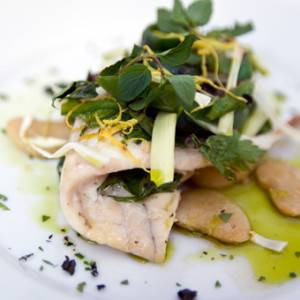
HL: Where do you like to dine when you’re not working?
CD: Joan and I work seven days and nights per week, so we rarely go out to eat. When we do (usually taking a break from our work in the office on Mondays, when we’re closed for service,) we like to drop into a new restaurant called The Gallows for a quick bite. We know the chef and general manager, both of whom worked with us while they were under construction at their restaurant. Seth Morrison, the chef, is very talented and his food has a deceptive simplicity and cleanness to it that we really enjoy. He is evangelical about sourcing local and mostly organic ingredients. His use of herbs is subtle and layered, yet still pronounced. We also like to grab a few dishes—almost anything, really—from Myers & Chang. I love the boldness in spice and herbs that Joanne uses. She has absolutely no fear in her cooking, and her ingredients are impeccable and lovely. Toro is also a good spot, as is Coppa.
HL: What’s your ideal meal?
CD: If I had to have one for the rest of my life, it would be a beautifully roasted chicken, particularly with rosemary, lemon, and thyme. And I would add some nice soft cheese, like taleggio or epoisses, with very ripe pears or white nectarines for dessert. If I were to select a first course, it would be the woodsy, rich minestrone my cousins used to serve us every day in Piemonte. The minestrone was served to us for every lunch, and again to start every dinner, and I never tired of it. To this day, the smell of a good chicken broth with parmegiano reggiano is the single scent that I identify most with Italy.
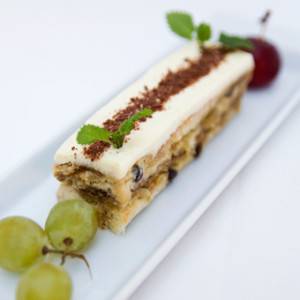
HL: Where do you like to dine for a special occasion?
CD: I worked for 5 years at No.9 Park, and I still think that it is one of the very best restaurants in the city. But I rarely dine in a restaurant that I work in, or have worked in. I can’t say why, I just don’t. To me Troquet is the best restaurant in town in terms of food, which is all that really matters to me. I would dine there all the time, if I had the time and the resources. It is the closest thing to a New York fine dining experience that one can have in Boston. (The chef, Scott Hebert, used to work with Scott Bryan at Veritas.) Otherwise, IF it were practical, I would go on an annual dining safari to New York, and probably dine at least once each trip at Jean-Georges. I loved the food we were cooking many years ago at Restaurant Jean-Claude, in the Village. I hear it is still the same as it was, and very worth the trip.
HL: What do you love about Boston?
CD: For one, it’s the best sports town in the World…and there are parks everywhere you look. But I love that Boston is a big little town. There are all of the amenities of city living, but in a European village kind of way. I think it must be the most European-feeling of all American cities, and I love the fact that one can walk across the entire town in 15-20 minutes. There are movies, movie festivals, plays, play festivals, jazz clubs, jazz festivals, restaurants, and neighborhood restaurant festivals available throughout the year. All these festivals are in celebration of a very youthful city, whose population is half college students, who are full of optimistic vigor. And yet, it is one of the oldest cities in the country with grand old architecture and social traditions.
HL: What do you like to do on your days off?
CD: That’s a trick question, as I don’t take days off. I don’t believe in them for a restaurant owner and chef. In my other life, I am also a playwright, so if I had some time off, I would find a nice café, set up a stack of steno notebooks and sharpened pencils, and work on some of the plays that have been haunting my sleeping mind.
HL: Your favorite vacation destination?
CD: It’s been many years since I’ve taken one, and it will probably be after the remaining 9 years of our restaurant lease run out before I take one again, but I really enjoy the Cape—particularly the rich solitude of Truro at night, watching the moon shards sail along the surf. I also long and ache to return to the village of Salogni in the Alessandria hills of Piemonte. It has been a very long time since I’ve been there. I have dual citizenship, so if I get there some day, I may not return to the United States. I might just go up into the hills with some goats and make cheese in a hut. That would be a nice ending for me.
HL: What’s your most memorable meal?
CD: When I moved to Boston, in the mid-eighties, I worked as a line cook at L’Espalier. There were only two or three serious restaurants at that time: L’Espalier, Jasper’s, which had recently opened and had a menu of oysters with mignonette, steak frites, and lobster with butter. Jimmy Burke had Allegro going, and that was pretty much it for the Boston dining scene. (Lydia hadn’t come back to Boston yet to open Biba.) Many of the younger cooks (myself included, that’s how long ago this was!) were talking about this fantastic chef in a hotel downtown, whose name nobody could remember, or pronounce. It was said that he was Austrian and French (I later found out he was Alsatian.) The hotel was the Swissotel, the restaurant was the Le Marquis de Lafayette, and the chef was, of course, a very young Jean-Georges Vongerichten in his first gig in the United States. I received a gift certificate of $150 from my brother to dine in the restaurant, which I thought was extravagant, but actually covered less than half of my final bill. I had the 9 course tasting menu, and my girlfriend at the time opted for 3 selections from the a la carte menu. I’m so glad that she did. I remember all 12 dishes, plus the dessert cart, as if it were yesterday. That meal changed my life (a bad cliché, I know, but in this case very true). I went from being a jaded chef feeling stale in a profession that seemed to offer little change or interest beyond what I had already mastered, to a neophyte cook with a world of strange and mesmerizing culinary geography to explore. Endless tastes, textures, and techniques, all exotic, and all enticing were presented to me in that one meal. I was Charlie opening secret doors to wonderful wonders in the chocolate factory, and I didn’t want it to ever end—and it hasn’t.
HL: What are your five favorite ingredients?
CD: Not necessarily the core ones which are most essential to my food, but the ones I most enjoy and make menu allowances for:
1.) Saffron
2.) All fresh herbs, but particularly lavender and marjoram (no other herbs remind me so vividly of the roads and fields around Salogni).
3.) Honey
4.) Chocolate
5.) Joan, as my dining companion, without whom nothing else has any savor.
erbaluce is located at 69 Church St; 617-426-6969
To contact Tracey Ceurvels, visit her blog, The Busy Hedonist, or email her.







